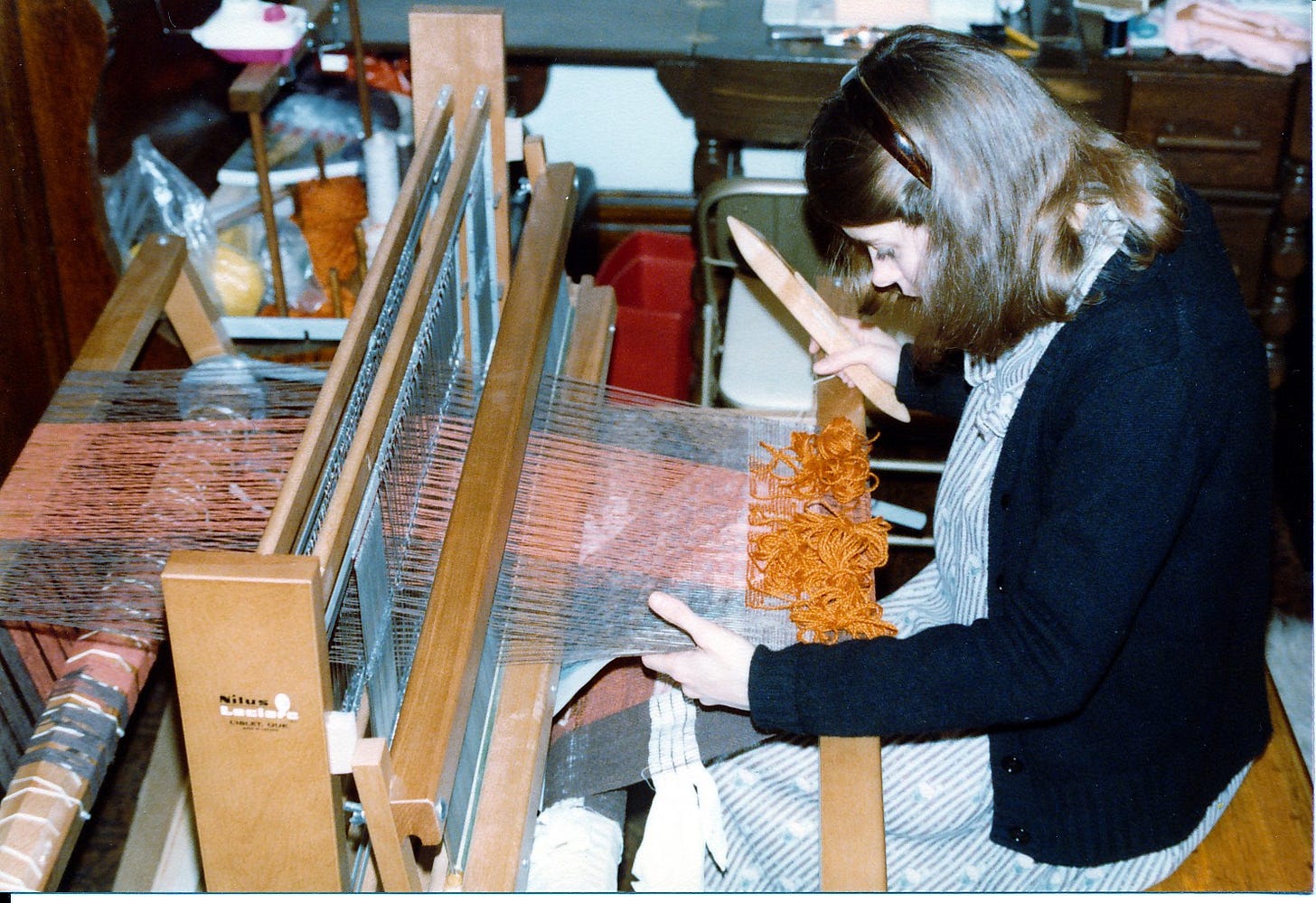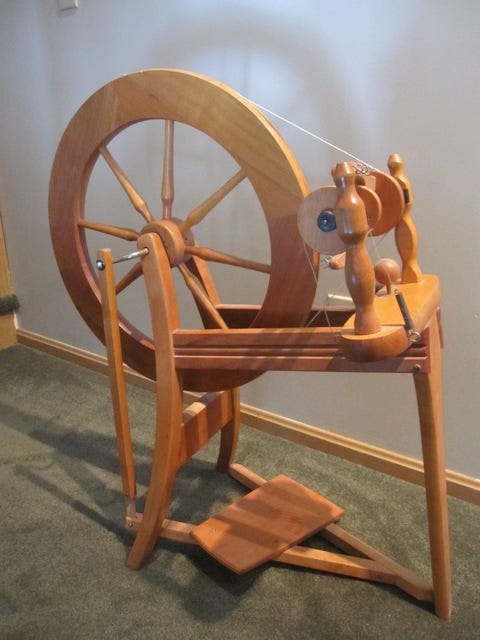I first became interested in Scandinavian weaving when I became a weaver myself. I’d always done handwork—sewing my own clothes, knitting, cross-stitch, and needlepoint. I was always interested in weaving—you could say that it was in my blood. The estate sales of my ancestors included rug looms, floor looms, walking wheels, wool cards, and other fiber equipment, but that knowledge was lost before it came to me. I didn’t know any weavers, or how to get started. In the late 1970’s, a weaving shop opened in my community, and that became the point of contact for learning and joining with other handweavers in the area.
Swedish weaving design was popular in the U.S. Though I started with a Leclerc loom, made in Canada, I eventually moved on to a Swedish loom, an eight-shaft Glamakra, and bought a Louet spinning wheel, from Holland
.Once my loom was set up, warped, and properly threaded, I found weaving to be a soothing, relaxing, almost spiritual experience—the clatter of the treadles, the shoosh of the shed opening, the rhythm of the shuttle passing from hand to hand, the scent of lanolin. It occupied the body, but freed the mind. Many of my stories began at the loom.
Spinning on an upright wheel was even more transcendent, between the cadence of the treadles, the drawing out of the fiber, the release onto the bobbin. Even the names of the parts—mother-of-all, the maidens—served to connect me to generations of women before me. Weaving preceded the other fiber arts—knitting, crocheting, sewing. As long as it remained in the home, it was considered women’s work. It was not until the production of textiles became industrialized that men showed an interest.
Consider the many ways weaving and spinning has found its place in our language. We “spin” tales, we “weave” a web of lies, or a spell to ensnare a person. We follow the thread of a conversation, or life hangs by a thread. When we speak of the “distaff” side, we speak of women (a distaff being a tool to hold fiber while spinning.) We communicate using the world wide web, and DNA is described as plied strands. Spinning, especially, is feminine in that it, in effect, creates something useful (thread) out of nothing (raw fiber) and because the work of spinning is never done. A woman who never marries is called a “spinster,” presumably because she has plenty of time for spinning. After a political event, journalists go to a “spin room,” where candidates’ staff try to spin whatever was said and done.
For me, spinning and weaving was a past time, a hobby, a creative outlet, the continuation of a tradition. In northern Europe during and prior to the Viking age, fiber arts played a critical role in the agrarian economy. Home textile production was truly a “sheep to shawl” (flax to fabric?) domestic enterprise—the only source of clothing, bedlinens, and the distinctive sails that propelled Viking ships around the world. It’s been estimated that one longship sail required the wool of a thousand sheep and might be two years in the making.
As Claire Eamer says, “No wool, no Vikings.”
The Vikings were great sailors and fearsome warriors, but they couldn’t have left port without wool. It provided the raw material for their clothes, their blankets, even the sails that harnessed the wind for their ships.
It was women who produced it.
Women were masters and commanders on Viking farms, overseeing livestock, crops and produce gardens, processing and preserving food by salting, drying, and fermenting it. Though they grew and processed flax to make linen, most of their textiles were made of wool. They plucked wool from sheep, cleaned it, carded it using hand wool cards, and spun it with drop spindles and distaffs. Finally, they wove it into fabric on upright, warp-weighted looms. Though spindle spinning could be done most anywhere, much of this had to be done in the smoky dark of longhouses, often on long winter nights.
It’s impossible to overstate the time investment in making fabrics in those days, which explains the focus on cleaning and mending torn clothing. I felt truly fortunate that I did not have to spin wool using a drop spindle and weave on a warp-weighted upright loom.
Truly fortunate.
Warp weights were often made of fired clay, and sometimes of soapstone or metal. They were often found in the graves of women in the Medieval period. In Children of Ragnarok, Liv includes a warp weight with her step-modir’s grave goods.
Knitting had not been invented in the Viking age, but socks and other items were produced by nalbinding, a fiber technique that used a single needle.
Belts and sashes were often produced using card-weaving.
In Children of Ragnarok, I’ve tried to recreate a world in which the ruining of a shirt is a catastrophe, and the making of a sail could take longer than the building of a ship. But spinning and weaving had a greater importance in Viking Age Europe than as a textile technique. Spinning and weaving were portals to magic—to sorcery of a kind only women could wield. I’ll have more on that next time.
Eamer, Claire, https://hakaimagazine.com/features/no-wool-no-vikings/










Somehow, I didn't know you're a fiber artist, too! Oh the conversations we could have been having this whole time!
I suspect you've already read it, but just in case you haven't, may I recommend Women's Work: The First 20,000 Years Women, Cloth, and Society in Early Times by Elizabeth Wayland Barber? I read it recently and really got a lot out of it.
A few years ago, a Canadian Production Wheel came into my life. It's an old wheel -- at least 100 -- and every time I sit at it, I think about the women who sat at it before me. I don't know who they were, but I feel connected to them through this tool that's survived all these years.